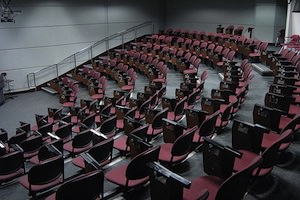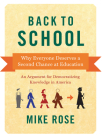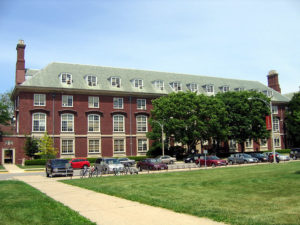Who Should Go to College?
The college-for-all versus occupational training debate is typically focused on structural features of the K-12 curriculum and on economic outcomes with little attention paid to the intellectual and emotional lives of the young people involved -- their interests, what has meaning for them, what they want to do with their lives. The college-for-all versus occupational training debate pays little attention to the intellectual and emotional lives of the young people involved.
The following is an edited excerpt from Mike Rose’s latest book, “Back to School: Why Everyone Deserves a Second Chance at Education.”
When I was in high school in the early 1960s, the curriculum was split into three tracks: academic/college preparatory, general education and vocational. Upon entrance, students were placed in one of them based on their previous academic records or a measure of ability, typically an IQ score. The curriculum directed us toward a four-year college or university, possibly a community college; service or low-level managerial careers; or blue-collar work. The curriculum also contributed powerfully to our school’s social order. The college bound were in student government, edited the newspaper and the annual, and at year-end had a thick list of activities under their class photographs. Looking back on it all, the college prep crowd walked around campus with an air of promise.
Since the mid-20th century, sociological and educational studies have documented the bias at work in the way students got placed in these tracks. For example, working-class and racial and ethnic minority students with records of achievement comparable to their advantaged peers were more frequently being placed in the general ed or vocational tracks rather than the college prep one. And there was the broader concern that this way of educationally stratifying young people was simply undemocratic. Eminent American philosopher John Dewey called it “social predestination.”
A remarkable amount of effort by educators, policymakers, advocacy groups and parents has resulted over the last few decades in a dismantling of formal tracking. Though patterns of inequality still exist in the courses students take — vocational classes are overpopulated by poorer kids — we have in our time witnessed the emergence of a belief that college is a possibility for everyone. Today, however, we are also seeing the rise of a strong counter-voice, doubtful about the individual and societal value of channeling all young people into postsecondary education.
The skeptics are a diverse group. Many are economists who point to trends in the labor market that reveal a number of good and growing jobs that require some postsecondary occupational training but not a four-year — or even two-year — degree. Some are educators (including, but not limited to, career and technical education interest groups) who emphasize the variability of students’ interests and aptitudes, not all of which find fulfillment in a college curriculum. And some are social commentators who blend the economic and educational arguments with reflection on the value of direct contact with the physical world, something increasingly remote in our information age. Though these skeptics come from a range of ideological backgrounds, they share a concern that in pushing postsecondary education for everyone, we perpetuate a myth that personal fulfillment and economic security can be had only by pursuing a college degree.
This debate is an important one and is of interest to me because it directly affects the kinds of students I’ve been concerned with my entire professional life: those who come from less-than-privileged backgrounds and aren’t on the fast track to college. But my worry is that, as is the case with so many education debates, it will devolve into a binary polemic. The predictable result will be a stalemate or a partial and inadequate solution that will not address the web of concerns that underlies this discussion or honor the lives of the young people at the heart of it.
Back to School: Why Everyone Deserves a Second Chance at Education
By Mike Rose
New Press, 224 pages
Let me begin by acknowledging current labor market realities, for many low-income students are in immediate financial need. These students can commit to postsecondary education only if it leads to a decent wage and benefits. Furthermore, the record of postsecondary success is not a good one. Many students leave college without a certificate or degree that can help them in the job market, and, in many cases, they incur significant debt. There are good jobs out there that require training but not a two- or four-year degree, jobs that are relatively secure in a fluid global economy. The plumber’s and the chef’s work cannot be outsourced.
It is also true — and anyone who teaches and, for that fact, any parent knows it — that some young people are just not drawn to the kinds of activities that comprise the typical academic course of study, no matter how well executed. In a community college fashion program I’ve been studying, I see students with average to poor high school records deeply involved in their work, learning techniques and design principles, solving problems, building a knowledge base. Yet they resist, often with strong emotion, anything smacking of the traditional classroom, including the very structure of the classroom itself. This resistance holds even when the subject (textiles, history of fashion) relates to their interests.
The college-for-all versus occupational training debate is typically focused on structural features of the K-12 curriculum and on economic outcomes with little attention paid to the intellectual and emotional lives of the young people involved — their interests, what has meaning for them, what they want to do with their lives. A beginning student in a welding program gave succinct expression to all this, saying: “I love welding. This is the first time school has meant anything to me.”
The problem is that historically the vocational curriculum itself has not adequately honored the rich intellectual content of work. As the authors of an overview of such high school programs from the National Center for Research in Vocational Education put it, vocational education “emphasized job-specific skills to the almost complete exclusion of theoretical content.” And the general education courses — English, history, mathematics — that vocational students took were typically dumbed down and unimaginative. Reforms over the past few decades have gone some way toward changing this state of affairs, but the overall results have been uneven.
The huge question then is this: Is a particular vocationally oriented program built on the cognitive content of work and does it provide a strong education in the literacy and mathematics, the history and economics, the science and ethics that can emerge from the world of work? Few of the economists I’ve read who advocate an expansion of career and technical education address the educational (versus job training) aspects of their proposals. Another point that the skeptics make is the troubling record of student success in postsecondary education. Do we really want to urge more students into a system that on average graduates about 50 to 60 percent of those who enter it? The doubters are right about the unsatisfactory record of student achievement. But their solution seems to fault students more than the colleges they attend and affords no other option but to redirect students who aren’t thriving into job-training programs.
We need to be careful about painting this broad group of students with a single brush stroke. Some are strongly motivated but because of poor education, family disruption, residential mobility or a host of reasons, they are not academically prepared. The question is what kind of course work and services does the college have to help them. (And it should be noted that many vocational programs recommended by the skeptics would require the same level of academic remediation.) Some students are unsure about their future and are experimenting. In my experience, it’s not easy to determine in advance who will find their way. We also know that a significant number of students leave college temporarily or permanently for nonacademic reasons such as finances, child care or job loss. Some of these cases could be addressed with financial aid or other resources and social services. So although I take the doubters’ point about the poor record of student success and agree that college is not for everyone and that a fulfilling life can be had without it, it is a simplistic solution to funnel everyone who is not thriving into a vocational program.
Such a solution also smacks of injustice. Right at the point in our society when college is being encouraged for a wide sweep of the population, we have the emergence of a restrictive counterforce that is seen by some as an attempt to protect privilege, or, at the least, as an ignorance of social history. Research by sociologists Jennie Brand and Yu Xie demonstrates that those least likely to attend college because of social class position — and thus, on average, have a less privileged education — are the ones who gain the most economically from a college degree. For such populations, going to college can also provide a measure of social and cultural capital. There is a long history of exclusion that has to be addressed before countering broad access to higher education.
All the above raises the basic question: What is the purpose of education? Both the college-for-all advocates and the skeptics justify their positions on economic grounds, but another element in the argument is that in addition to enhancing economic mobility, going to college also has important intellectual, cultural and civic benefits. These different perspectives on the purpose of college play into — and are shaped by — a long-standing tension in American higher education: a conflict between the goal of cultivating intellectual growth and liberal culture versus the goal of preparing students for occupation and practical life. I think this tension — like the divide between the academic and vocational — restricts the conversation we should be having. We should be asking how can we enhance the liberal studies possibilities in a vocational curriculum and enliven and broaden the academic course of study through engagement with the world beyond the classroom.
A third option beyond college or work has emerged in the last few years: Linked Learning, which is also known by its former name, Multiple Pathways. There are various incarnations of Linked Learning, but a common one is a relatively small high school that is theme based and offers a strong academic curriculum for all students; the students then have options to branch off toward a career, an occupational certificate or a two- or four-year degree.
Back to School: Why Everyone Deserves A Second Chance at Education
By Mike Rose
New Press, 224 pages
It is important to remember here that goals, expectations and what students imagine for themselves are deeply affected by information and experience. For a multiple pathways approach to be effective, students will need a lot of information about colleges and careers and plentiful opportunities to visit campuses and potential work sites such as hospitals, courts and laboratories. The differences in cultural and social capital between my UCLA students and those I know at inner-city community colleges are profound and widening as inequality increases in our country. Pathways advocates will have to confront this inequality head-on, for it is as important as the content of curriculum.
The college-for-all supporters would applaud an emphasis on a strong academic core but worry that this system could devolve into a new form of tracking. And the college-for-all skeptics, I suspect, would applaud the presence of a vocational pathway, though worry that anti-vocational biases would still stigmatize the option. These are legitimate concerns, and many backers of the Linked Learning approach acknowledge them. The advocates also realize the significant challenges facing such a reform: faculty development, curriculum design and the ancillary academic and social services needed to provide a quality pre-pathways education for all students. Still, this is a promising alternative, and some schools are demonstrating success with it.
Though this college versus work debate can slip into a reductive either/or polemic, it does raise awareness of a number of important issues, ones not only central to education but also to the economy, the meaning of work and democratic life. These include the skyrocketing cost of college and the poor record of retention and graduation in higher education. The discussion also focuses attention on the disconnect between the current labor market and the politically popular rhetoric of “educating our way into the new economy.” And the debate demonstrates the significant commitment of financial and human resources that will be needed to make college-for-all a reality.
On a broader scale, the conversation considers the purpose of education in a free society. The issues here include the variability of human interests and talents and the class-based bias toward entire categories of knowledge and activity — a bias institutionalized in the structure of the American high school. There is, then, the need to rethink the academic-vocational divide itself and its postsecondary cousin, the liberal ideal as opposed to the vocational mission of the college. And finally we need to keep in mind that the college-for-all versus work debate takes place within a history of inequality and that the resolution will involve not only educational and economic issues, but civic and moral ones as well.
Your support matters…Independent journalism is under threat and overshadowed by heavily funded mainstream media.
You can help level the playing field. Become a member.
Your tax-deductible contribution keeps us digging beneath the headlines to give you thought-provoking, investigative reporting and analysis that unearths what's really happening- without compromise.
Give today to support our courageous, independent journalists.





You need to be a supporter to comment.
There are currently no responses to this article.
Be the first to respond.